Celebrating 50 Years of X-ray Astronomy:
Brief Satellite Timeline
This is a brief timeline of X-ray telescopes and satellite that our scientists talk about in their interviews. For a full timeline of X-ray astronomy, check out A Brief History of High-Energy (X-ray & Gamma-Ray) Astronomy.
Uhuru
December 1970 - March 1973
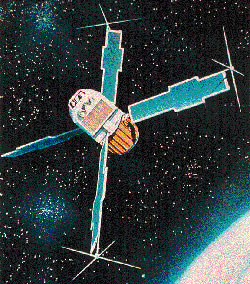
(Credit: NASA)
Uhuru launched in December 1970 from the San Marco platform in Kenya. It was the first earth-orbiting mission dedicated entirely to celestial X-ray astronomy.
Visit the Uhuru mission page
7th Orbiting Solar Observatory (OSO-7)
September 1971 - July 1974
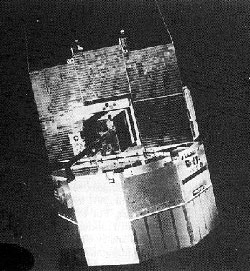
(Credit: NASA)
The 7th Orbiting Solar Observatory mission was launched in Septermber 1971 onboard a Delta rocket. It was primarily a solar observatory designed to point a battery of UV and X-ray telescopes at the Sun from a platform mounted on a cylindrical wheel. However, it also carried propotional counters to observe cosmic X-ray sources.
Visit the OSO-7 mission page.
Ariel-5
October 1974 - March 1980
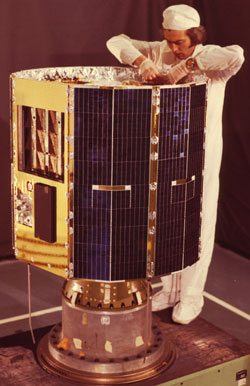
(Credit: NASA)
Ariel V was launched in October 1974 from the San Marco launch platform in the Indian Ocean. The mission was a British-USA collaboration. The Science Research Council managed the project for the UK and GSFC/NASA for the USA. Ariel V was dedicated to monitoring the X-ray sky with a comprehensive payload. The mission ended in the spring of 1980.
Visit the Ariel- 5 mission page.
8th Orbiting Solar Observatory (OSO-8)
June 1975 - October 1978

(Credit: NASA)
The 8th Orbiting Solar Observatory (OSO-8) was launched in June 1975 onboard a Delta rocket. While its primary objective was to study the Sun, it also carried four instruments dedicated to studying X-rays from cosmic sources.
Visit the OSO-8 mission page
Rossi X-Ray Timing Explorer (RXTE)
December 1995 - January 2012
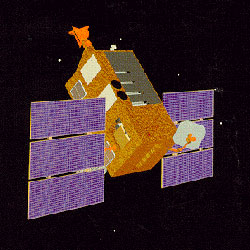
(Credit: NASA)
The Rossi X-ray Timing Explorer (RXTE) was launched in December 1995 from NASA's Kennedy Space Center. The mission featured unprecedented time resolution in combination with moderate spectral resolution to explore variability in X-ray sources.
Visit the RXTE Learning Center.
Chandra X-ray Observatory (Chandra)
July 1999 - Present

(Credit: NASA/CXC/NGST)
The Chandra X-ray Observatory was launched and deployed by the Space Shuttle Columbia in July 1999. The mission was designed to observe X-rays from high-energy sources in the universe, such as the remnants of exploded stars.
Visit the Chandra Website
XMM-Newton
December 1999 - Present

(Credit: ESA)
XMM-Newton is a joint European Space Agency (ESA)-NASA mission launched in December 1999 from the ESA base at Kourou, French Guiana. It was designed to observe high-energy X-rays emitted from exotic astronomical objects such as pulsars, black holes and active galaxies.
Visit the XMM-Newton Education and Public Outreach Site
Integral
October 2002 - Present

(Credit: ESA/Medialab)
The International Gamma-Ray Astrophysics Laboratory (INTEGRAL) was launched in July 2005 aboard a Russian Progon rocket. It is a project of the European Space Agency and was the first observatory to have the capability of observing gamma rays, X-rays and visible light simultaneously.
Visit the INTEGRAL mission page.
Suzaku
July 2005 - Present
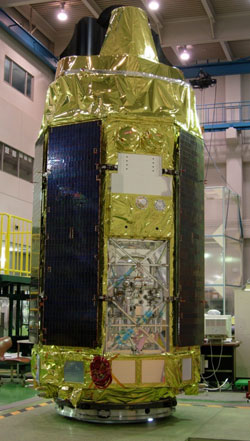
(Credit: NASA)
Suzaku was launched in July 2005 from the Uchinoura Space Center in Japan. It was Japan's fifth X-ray astronomy mission, and was developed in collaboration with NASA's Goddard Space Flight Center and institutions in the U.S. and Japan.
Visit the Collaboration Across Cultures website to learn more about all of the NASA-JAXA collaborations in X-ray astronomy.
NuSTAR
June 2012 - Present

(Credit: NASA/JPL)
NuSTAR was launched in June 2012 from a L-1011 "Stargazer" aircraft. It is the first focusing high energy X-ray mission and will search for black holes, map supernova explosions, and study the most extreme active galaxies.
Visit the NuSTAR Education and Public Outreach Site.
Astro-H
Scheduled for launch in 2014
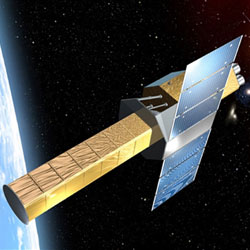
(Credit: ISAS/JAXA)
Astro-H is scheduled for launch in 2014. It will be Japan's sixth X-ray astronomy mission, and is under development in collaboration with NASA's Goddard Space Flight Center and institutions in Japan.
Visit the Collaboration Across Cultures website to learn more about all of the NASA-JAXA collaborations in X-ray astronomy.
Publication Date: June 2012


